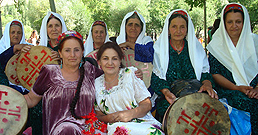Mahsa Hedayati
In truth, my first reaction upon learning about an opportunity to live and work in Tajikistan was: “Where exactly is that again?” I had heard about Tajikistan in the past, mainly as one of the former-Soviet “stans”, but my limited understanding of the country was always linked to its relationship to Russia. A whole new world opened up for me once I came to realize that Tajikistan was historically part of Persia and that Tajik people until this day speak a version of Farsi. The more I learned about Tajikistan’s history, the less I felt as though I was moving to a foreign land. That brought a sense of much needed comfort to me.
It was interesting because as soon as I landed in Dushanbe, and heard people speak in a language that my parents raised me with, I felt safe. I was also amazed to see how kind and hospitable Tajik people were to strangers including myself. Their warm character reminded me of my many visits to Iran. And it was wonderful to see that upon learning that I was Iranian, Tajiks throughout the country immediately treated me as one of their own. The way you treat a cousin you care for.
I did also feel that Dushanbe still encompassed a Soviet energy, despite the collapse of the union in 1991 – e.g. the Soviet buildings along Rudaki Avenue, the use of Russian in every day conversations, and the Russian cuisine that continues to be very popular among the Tajik population. I had heard that Dushanbe was quite a vibrant city during the Soviet era, but that following the collapse of the Soviet Union as well as the outbreak of the civil war, many Tajiks - including intellectuals - fled the country, leaving their homes and life in an unstable and uncertain Tajikistan behind. In truth, I sometimes felt that the void created by those events still remains in the streets of Dushanbe. In Farsi, there is a saying, “Jashun khali bud”. Indeed, that is what comes to mind when I think of the gap left by those migrants who if still remained, would have perhaps played an important role in the development of the country.
As I spent most of my time working in Badakshan, I came to learn about a region of the country that remains largely unknown to the outside world, including beyond the region of Badakhshan and into other parts of the country. I was working with Aga Khan Foundation, and was based in Khorog. However I travelled to almost all districts of the region and in the process came to learn new dimensions of Iranian history and people. This mountainous region was perhaps the most romantic and stunning place I have seen in my life. Given the often harsh living conditions in this highly mountainous area, very few industrial developments have taken place there. As such, everything is almost as God created it. Its natural beauty speaks to you – the mountains, the rivers, the orchards, the golden eagles. I truly sensed that a level of deep wisdom emanated from the elements in that region; a wisdom in part rooted in the elements themselves, as well as from the numerous empires throughout time which passed through the region and left their imprints on the land.
My father had told me that as a young boy in Iran, he was told that the capital of Badakhshan was called Khorog because that was where empires would deliberately stop and rest during their political ventures. That was the place to stop and eat – “Khorak”, which eventually became known as “Khorog”. Whether or not this is a myth, I would often picture the ancient Persian armies under the endless apricot trees I walked across, resting and reading poetry until they fell asleep along the magnificent mountains and rivers surrounding them. There is something very romantic and enchanting about that area, which in my eyes equated to the beauty of the famous rubies treasured within the mountains of that very region.
One of the things I found most interesting in Badakhshan was that people of the region continue to speak 7 different ancient-Iranian dialects, including Shughni, Rushani, Wakhani and Ishkashimi. The first time I heard someone speak Shughni, it was a strange experience, as I did not understand what the person was saying but felt the melody of his speech. This melody resembled the rhythm used in Farsi. Once I became aware of the history of Shughni as well as the other dialects, I often felt like I was living among my ancestors.
Living in Badakshan and in Dushanbe were two different experiences, but each helped me to better understand and appreciate the country as well as its connection to Iran and Persian history. I consider myself blessed to have had the opportunity to visit such a beautiful country and to essentially connect with a country and people who share a common history with Iran.


